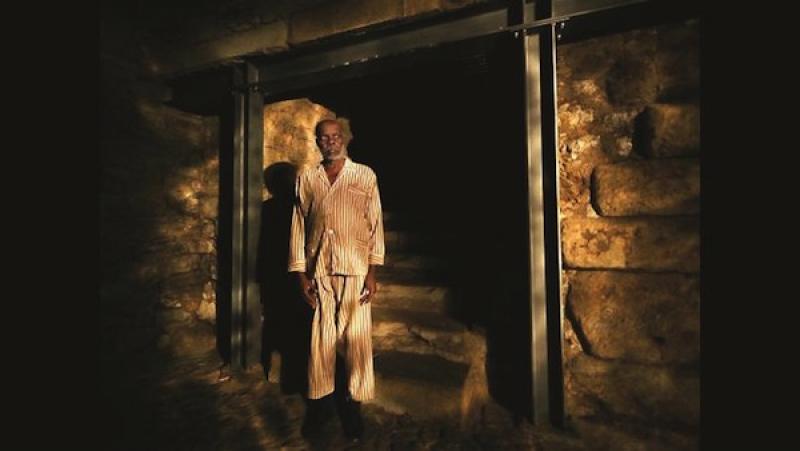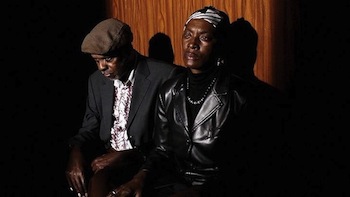Horse Money | reviews, news & interviews
Horse Money
Horse Money
The phantoms of Portuguese colonialism haunt Pedro Costa's masterpiece

Pedro Costa’s Horse Money begins with a silent montage of Jacob Riis’s grim photographs of late 19th-century Manhattan slum dwellers, some of them former slaves or their offspring. One photo shows a bowler-hatted young black man sitting athwart a barrel; beside him stands a white woman with a filthy face. The former looks like he had enough wits to survive the squalour for a while, the latter looks doomed.
There’s an immediate cut to a framed 1970s colour portrait of a handsome young African-Portuguese and then a pan to where the same man, Ventura, now in his seventies, descends a sloping passage until a white-coated attendant locks a door behind him. The labyrinth into which the viewer is following the sick, trembling but undefeated Ventura seems to be a terminally benighted asylum, hospital, or prison, but it’s really his addled mind, where the murky pathways of the past, the present, and the future intersect.
Such is the power of Costa’s filmmaking that the most vivid incident of 'Horse Money' isn’t shown
This beautiful, disturbing, and often agonizingly slow docufiction is the 56-year-old minimalist maestro’s fourth consecutive full-length statement of solidarity with the impoverished emigrants from the former Portuguese slave colony of the Cape Verde archipelago who settled in the Lisbon slum of Fontainhas. Colossal Youth (2006), Costa’s last feature, introduced Ventura, a non-professional playing a version of himself, wandering between his new home in a low-cost housing complex and the remnants of the cleared slum – and delusionally recognising as his children some of the survivors of Costa’s Ossos (1997) and In Vanda’s Room (2000).
Having been beaten (or having recollected being beaten) by soldiers, Ventura is visited in a sick room by a group of old mates and his nephew – that is, in the film’s non-naturalistic convergence of Ventura’s present reality and imagined present, he converses again with his long-dead colleagues.
He recalls how each of them suffered cruelly working as bricklayers, masons, or pavers. One ended up burning himself and his family to death. Another, an epileptic, was involved in a fatal accident. Yet another, who augmented his income selling drugs, “needs a shot every day”. Ventura built up a life for himself, but “mould in the walls” of his house – a metaphor for social malaise as well as a mycotoxin – bequeathed him his nervous disease and cost him his job. As Costa did with the mesmerizing Vanda Duarte (a survivor of heroin addiction) and her sister Zita (who died), Costa partially based his film on Ventura’s reminiscences of struggle, misfortune, and misapplied will, all the result of his oppression and exploitation.
 Such is the power of Costa’s filmmaking that Horse Money’s most vivid incident isn’t shown. Nearly 40 years later, it consumes Ventura with guilt. On 9 March 1975, the day an attempted rightist coup failed to undo the Carnation Revolution that had brought down Portugal's fascist government the year before, he and Joaquin Varela (Tito Furtado), a fellow emigrant, slashed each other with knives on a Fontainhas street. Varela’s red shirt (seen eventually) suggests he was a leftist; Ventura, who had a habit of running from the revolutionary MFA soldiers, was a dissident or coward. Varela died in 2013, never having recovered. A shadow of Ventura’s estranged wife in Cape Verde, Varela’s widow Vitalina (the real name of the formidable actress, pictured above with Ventura) tragically couldn’t get a visa in time to make his funeral. Yet she visits Ventura at his Gothic institution to tell him he destroyed all their lives. Her smile on leaving him hints at a rapprochement – though it could be she’s another ghost, one from whom he needs forgiveness. In a film of uncertainties, the same is certainly true of Varela, whom Ventura treats with brotherly affection after he rises from the grave in that red shirt.
Such is the power of Costa’s filmmaking that Horse Money’s most vivid incident isn’t shown. Nearly 40 years later, it consumes Ventura with guilt. On 9 March 1975, the day an attempted rightist coup failed to undo the Carnation Revolution that had brought down Portugal's fascist government the year before, he and Joaquin Varela (Tito Furtado), a fellow emigrant, slashed each other with knives on a Fontainhas street. Varela’s red shirt (seen eventually) suggests he was a leftist; Ventura, who had a habit of running from the revolutionary MFA soldiers, was a dissident or coward. Varela died in 2013, never having recovered. A shadow of Ventura’s estranged wife in Cape Verde, Varela’s widow Vitalina (the real name of the formidable actress, pictured above with Ventura) tragically couldn’t get a visa in time to make his funeral. Yet she visits Ventura at his Gothic institution to tell him he destroyed all their lives. Her smile on leaving him hints at a rapprochement – though it could be she’s another ghost, one from whom he needs forgiveness. In a film of uncertainties, the same is certainly true of Varela, whom Ventura treats with brotherly affection after he rises from the grave in that red shirt.
Named for Ventura’s horse Dinheiro, which was “torn apart by vultures” around the time he lost his livelihood and all his Cape Verde property, Horse Money has a stylistic debt to the German Expressionism of Fritz Lang and the Val Lewton school of restrained, dread-laden chillers. Howard Hawks’s championing of male professionalism registers in the pride and fellowship of Ventura and his builder mates; his harbouring of a dark side echoes the psychological duality in some John Ford heroes. The key influence though was Not Reconciled (1965), Jean-Marie Straub and Danièle Huillet’s stark deconstruction of history – as the chronological process that produced Nazism – into a timeless phenomenon of recurrent patterns. The plight of Horse Money’s Cape Verdeans was suffered and will be suffered in the future by all underclasses created by capitalism, imperialism, and betrayed democracy.
Overleaf: watch the trailer for Horse Money
rating
Explore topics
Share this article
The future of Arts Journalism
You can stop theartsdesk.com closing!
We urgently need financing to survive. Our fundraising drive has thus far raised £49,000 but we need to reach £100,000 or we will be forced to close. Please contribute here: https://gofund.me/c3f6033d
And if you can forward this information to anyone who might assist, we’d be grateful.

Subscribe to theartsdesk.com
Thank you for continuing to read our work on theartsdesk.com. For unlimited access to every article in its entirety, including our archive of more than 15,000 pieces, we're asking for £5 per month or £40 per year. We feel it's a very good deal, and hope you do too.
To take a subscription now simply click here.
And if you're looking for that extra gift for a friend or family member, why not treat them to a theartsdesk.com gift subscription?
more Film
 Sorry, Baby review - the healing power of friendship in the aftermath of sexual assault
Eva Victor writes, directs and stars in their endearing debut feature
Sorry, Baby review - the healing power of friendship in the aftermath of sexual assault
Eva Victor writes, directs and stars in their endearing debut feature
 Blu-ray: Who Wants to Kill Jessie?
Fast-paced and visually inventive Czech comedy
Blu-ray: Who Wants to Kill Jessie?
Fast-paced and visually inventive Czech comedy
 Oslo Stories Trilogy: Love review - freed love
Gay cruising offers straight female lessons in a heady ode to urban connection
Oslo Stories Trilogy: Love review - freed love
Gay cruising offers straight female lessons in a heady ode to urban connection
 Beating Hearts review - kiss kiss, slam slam
Romance and clobberings in a so-so French melodrama
Beating Hearts review - kiss kiss, slam slam
Romance and clobberings in a so-so French melodrama
 Materialists review - a misfiring romcom or an undercooked satire?
Writer-director Celine Song's latest can't decide what kind of film it is
Materialists review - a misfiring romcom or an undercooked satire?
Writer-director Celine Song's latest can't decide what kind of film it is
 theartsdesk Q&A: actor Leonie Benesch on playing an overburdened nurse in the Swiss drama 'Late Shift'
The Guildhall-trained German star talks about the enormous pressures placed on nurses and her admiration for British films and TV
theartsdesk Q&A: actor Leonie Benesch on playing an overburdened nurse in the Swiss drama 'Late Shift'
The Guildhall-trained German star talks about the enormous pressures placed on nurses and her admiration for British films and TV
 Freakier Friday review - body-swapping gone ballistic
Lindsay Lohan and Jamie Lee Curtis's comedy sequel jumbles up more than their daughter-mother duo
Freakier Friday review - body-swapping gone ballistic
Lindsay Lohan and Jamie Lee Curtis's comedy sequel jumbles up more than their daughter-mother duo
 Eight Postcards from Utopia review - ads from the era when 1990s Romania embraced capitalism
Radu Jude's documentary is a mad montage of cheesy TV commercials
Eight Postcards from Utopia review - ads from the era when 1990s Romania embraced capitalism
Radu Jude's documentary is a mad montage of cheesy TV commercials
 The Kingdom review - coming of age as the body count rises
A teen belatedly bonds with her mysterious dad in an unflinching Corsican mob drama
The Kingdom review - coming of age as the body count rises
A teen belatedly bonds with her mysterious dad in an unflinching Corsican mob drama
 Weapons review - suffer the children
'Barbarian' follow-up hiply riffs on ancient fears
Weapons review - suffer the children
'Barbarian' follow-up hiply riffs on ancient fears
 theartsdesk Q&A: filmmaker Dag Johan Haugerud on sex, love, and confusion in the modern world
The writer-director discusses first-love agony and ecstasy in 'Dreams', the opening UK installment of his 'Oslo Stories' trilogy
theartsdesk Q&A: filmmaker Dag Johan Haugerud on sex, love, and confusion in the modern world
The writer-director discusses first-love agony and ecstasy in 'Dreams', the opening UK installment of his 'Oslo Stories' trilogy

Add comment